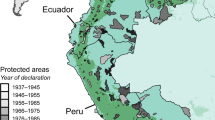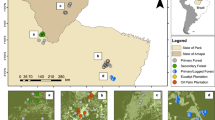Abstract
A major obstacle to conserving tropical biodiversity is the lack of information as to where efforts should be concentrated. One potential solution is to focus on readily assessed indicator groups, whose distribution predicts the overall importance of the biodiversity of candidate areas1,2. Here we test this idea, using the most extensive data set on patterns of diversity assembled so far for any part of the tropics. As in studies of temperate regions2,3,4,5,6,7,8, we found little spatial congruence in the species richness of woody plants, large moths, butterflies, birds and small mammals across 50 Ugandan forests. Despite this lack of congruence, sets of priority forests selected using data on single taxa only often captured species richness in other groups with the same efficiency as using information on all taxa at once. This is because efficient conservation networks incorporate not only species-rich sites, but also those whose biotas best complement those of other areas9,10,11. In Uganda, different taxa exhibit similar biogeography, so priority forests for one taxon collectively represent the important forest types for other taxa as well. Our results highlight the need, when evaluating potential indicators for reserve selection, to consider cross-taxon congruence in complementarity as well as species richness.
This is a preview of subscription content, access via your institution
Access options
Subscribe to this journal
Receive 51 print issues and online access
$199.00 per year
only $3.90 per issue
Buy this article
- Purchase on Springer Link
- Instant access to full article PDF
Prices may be subject to local taxes which are calculated during checkout


Similar content being viewed by others
References
Kremen, C.et al. Terrestrial arthropod assemblages: their use in conservation planning. Conserv. Biol. 7, 796–808 (1993).
Flather, C. H., Wilson, K. R., Dean, D. J. & McComb, W. C. Identifying gaps in conservation networks: of indicators and uncertainty in geographic-based analyses. Ecol. Appl. 7, 531–542 (1997).
Prendergast, J. R., Quinn, R. M., Lawton, J. H., Eversham, B. C. & Gibbons, D. W. Rare species, the coincidence of diversity hotspots and conservation strategies. Nature 365, 335–337 (1993).
Lombard, A. T. The problems with multi-species conservation: do hotspots, ideal reserves and existing reserves coincide? S. Afr. J. Zool. 30, 145–163 (1995).
Gaston, K. J. Biodiversity — congruence. Prog. Phys. Geog. 20, 105–112 (1996).
Gaston, K. J. in Aspects of the Genesis and Maintenance of Biological Diversity (eds Hochberg, M. E., Clobert, J. & Barbault, R.) 221–242 (Oxford Univ. Press, Oxford, (1996)).
Oliver, I. & Beattie, A. J. Designing a cost-effective invertebrate survey: a test of methods for rapid assessment of biodiversity. Ecol. Appl. 6, 594–607 (1996).
Kerr, J. T. Species richness, endemism, and the choice of areas for conservation. Conserv. Biol. 11, 1094–1100 (1997).
Pressey, R. L. & Nicholls, A. O. Efficiency in conservation evaluation; scoring versus iterative approaches. Biol. Conserv. 50, 199–218 (1989).
Pressey, R. L., Humphries, C. J., Margules, C. R., Vane-Wright, R. I. & Williams, P. H. Beyond opportunism: key principles for systematic reserve selection. Trends Ecol. Evol. 8, 121–128 (1993).
Williams, P. H.et al. Acomparison of richness hotspots, rarity hotspots, and complementary areas for conserving diversity of British birds. Conserv. Biol. 10, 155–174 (1996).
Pomeroy, D. Centers of high biodiversity in Africa. Conserv. Biol. 7, 901–907 (1993).
Howard, P. C. Nature Conservation in Uganda's Tropical Forest Reserves. (IUCN, Gland, (1991)).
Howard, P. C. & Davenport, T. R. B. (eds) Forest Biodiversity Reports Vols 1–33 (Uganda Forest Department, Kampala, (1996)).
Howard, P. C., Davenport, T. & Kigenyi, F. Planning conservation areas in Uganda's natural forests. Oryx 31, 253–264 (1997).
Pearson, D. L. & Cassola, F. World-wide species richness patterns of tiger beetles (Coleoptera: Cicindelidae): indicator taxon for biodiversity and conservation studies. Conserv. Biol. 6, 376–391 (1992).
Schall, J. J. & Pianka, E. R. Geographical trends in numbers of species. Science 201, 679–686 (1978).
Lawton, J. H.et al. Biodiversity inventories, indicator taxa and effects of habitat modification in tropical forest. Nature 391, 72–76 (1998).
van Jaarsveld, A. S.et al. Biodiversity assessment and conservation strategies. Science 279, 2106–2108 (1998).
Prendergast, J. R., Wood, S. N., Lawton, J. H. & Eversham, B. C. Correcting for variation in recording effort in analyses of diversity hotspots. Biodiv. Lett. 1, 39–53 (1993).
Ryti, R. T. Effect of the focal taxon on the selection of nature reserves. Ecol. Appl. 2, 404–410 (1992).
Sætersdal, M., Line, J. M. & Birks, H. J. B. How to maximize biological diversity in nature reserve selection: vascular plants and breeding birds in deciduous woodlands, western Norway. Biol. Conserv. 66, 131–138 (1993).
Dobson, A. P., Rodriguez, J. P., Roberts, W. M. & Wilcove, D. S. Geographic distribution of endangered species in the United States. Science 275, 550–553 (1997).
Csuti, B.et al. Acomparison of reserve selection algorithms using data on terrestrial vertebrates in Oregon. Biol. Conserv. 80, 83–97 (1997).
Faith, D. P. & Walker, P. A. How do indicator groups provide information about the relative biodiversity of different sets of areas?: on hotspots, complementarity and pattern-based approaches. Biodiv. Lett. 3, 18–25 (1996).
Oliver, I., Beattie, A. J. & York, A. Spatial fidelity of plant, vertebrate and invertebrate assemblages in multiple-use forest in eastern Australia. Conserv. Biol. 12, (in the press).
Colwell, R. K. & Coddington, J. A. Estimating terrestrial biodiversity through extrapolation. Phil. Trans. R. Soc. Lond. B 345, 101–108 (1994).
Oksanen, J. & Minchin, P. R. Instability of ordination results under changes in input data order: explanations and remedies. J. Veg. Sci. 8, 447–454 (1997).
Kershaw, M., Williams, P. H. & Mace, G. M. Conservation of Afrotropical antelopes: consequences and efficiency of using different site selection methods and diversity criteria. Biodiv. Conserv. 3, 354–372 (1994).
Williams, P. H. in Conservation in a Changing World (eds Mace, G. M., Balmford, A. & Ginsberg, J. R.) (Cambridge University Press, in the press).
Acknowledgements
We thank our colleagues in Uganda, especially members of the Forest Department field inventory teams, as well as R. Badaza, D. Duli, D. Hafashimana, I. Kapalaga, T.Katende, R. Kityo, E.Mupada, R. Nabanyumya, D. Olet, A. Rodgers, R. Murtland and T. Finch. Wealso thank P. Warren and J. Ward for help with analyses, and T. Birkhead, K. Gaston, J. Lawton, D.Pomeroy and P. Williams for comments on the manuscript. Most of the work was funded by the European Union and the Global Environmental Facility; P.V. was supported through the United Nations Food and Agriculture Organisation and J.S.L. and A.B. by the Darwin Initiative.
Author information
Authors and Affiliations
Corresponding author
Rights and permissions
About this article
Cite this article
Howard, P., Viskanic, P., Davenport, T. et al. Complementarity and the use of indicator groups for reserve selection in Uganda. Nature 394, 472–475 (1998). https://doi.org/10.1038/28843
Received:
Accepted:
Issue Date:
DOI: https://doi.org/10.1038/28843
This article is cited by
-
Using neutral landscape models to evaluate the umbrella species concept in an ecotone
Landscape Ecology (2023)
-
Beta diversity as an indicator of priority areas for Myrtaceae assemblage conservation in Subtropical Araucaria Forest
Biodiversity and Conservation (2020)
-
Low overlaps between hotspots and complementary sets of vertebrate and plant species in China
Biodiversity and Conservation (2018)
-
Higher taxa as surrogates for species richness in intertidal habitats of Qeshm Island in the Persian Gulf
Marine Biodiversity (2018)
-
Linking beta diversity patterns to protected areas: lessons from the Brazilian Atlantic Rainforest
Biodiversity and Conservation (2017)
Comments
By submitting a comment you agree to abide by our Terms and Community Guidelines. If you find something abusive or that does not comply with our terms or guidelines please flag it as inappropriate.



